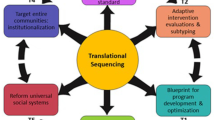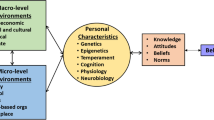Abstract
Prevention of substance use disorders (SUDs) applies research-driven interventions and policies that target modifiable individual-level and community-level factors to reduce the likelihood that an individual will engage in risky substance use behavior that may lead to a substance use disorder. Public health is an approach to reduce the individual and societal burden of addiction. It is grounded in epidemiology and health promotion to identify, understand, and reduce high-risk drug-using behaviors, promote SUD screening and treatment, and address underlying factors that may contribute to the societal burden of addiction, including poverty, stigma and discrimination, health inequities, and inadequate access to medication treatment. Public health policy involves regulations, rules, and laws designed to achieve a public benefit through shaping or controlling drug availability/access, use, and environmental factors that shape access and use. Evaluation of drug policies can provide important feedback to policymakers and clinicians to mitigate unintended negative consequences of public policy such as exacerbation of SUD problems (e.g., rise in heroin use when prescription opioids became less accessible). In this chapter, we describe approaches that clinicians can use to leverage their power to impact community health through prevention, public health, and policy. We frame prevention, public health, and public policy as interrelated approaches to reduce the societal impact and burden of substance use disorders.
Access this chapter
Tax calculation will be finalised at checkout
Purchases are for personal use only
Similar content being viewed by others
References
Brownson RC, Chriqui JF, Stamatakis KA. Understanding evidence-based public health policy. Am J Public Health. 2009;99(9):1576–83.
Butler JC. 2017 ASTHO president’s challenge: public health approaches to preventing substance misuse and addiction. J Public Health Manag Pract. 2017;23(5):531–6.
DeSimone EM, Tilleman JA, Kaku KA, Erickson CT. Expanding access to naloxone. US Pharmacist. 2018;43(3):16–20.
Prevention Solutions@EDC and SAMHSA. Preventing the consequences of opioid overdose: understanding naloxone access laws. SAMHSA’s Center for the Application of Prevention Technologies. [Internet]. 2018[cited 2019 June 26]; Available from: https://preventionsolutions.edc.org/sites/default/files/attachments/Preventing-Consequences-Opioid-Overdose-understanding-Naloxone-Access-Laws_0-1.pdf.
Laraque F, Varma JK. A public health approach to hepatitis C in an urban setting. Am J Public Health. 2017;107(6):922–6.
Peglow SL, Binswanger IA. Preventing opioid overdose in the clinic and hospital: analgesia and opioid antagonists. Med Clin North Am. 2018;102(4):621–34.
Pitt AL, Humphreys K, Brandeau ML. Modeling health benefits and harms of public policy responses to the US opioid epidemic. Am J Public Health. 2018;108(10):1394–400.
Ryan SA, Ammerman SD, Committee on Substance Use And Prevention. Counseling parents and teens about marijuana use in the era of legalization of marijuana. Pediatrics. 2017;139(3):e20164069.
SAMHSA. MAT statutes, regulations, and guidelines [Internet]. 2019 [cited 2019 May 17]. Available from: https://www.samhsa.gov/medication-assisted-treatment/statutes-regulations-guidelines.
SAMHSA. Laws and regulations [Internet]. 2019 [cited 2019 May 17]. Available from: https://www.samhsa.gov/about-us/who-we-are/laws-regulations.
SAMHSA. Medication and counseling treatment [Internet]. 2019 [cited 2019 May 17]. Available from: https://www.samhsa.gov/medication-assisted-treatment/treatment.
Chapter 5: Recovery: the many paths to wellness. In: Facing addiction in America: the surgeon general’s report on alcohol, drugs, and health [Internet]. US Department of Health and Human Services; 2016 [cited 2018 Nov 16]. Available from: https://www.ncbi.nlm.nih.gov/books/NBK424846/.
van Boekel LC, Brouwers EPM, van Weeghel J, Garretsen HFL. Stigma among health professionals towards patients with substance use disorders and its consequences for healthcare delivery: systematic review. Drug Alcohol Depend. 2013;131(1):23–35.
Author information
Authors and Affiliations
Corresponding author
Editor information
Editors and Affiliations
Review Questions
Review Questions
-
1.
A 23-year-old female and her boyfriend present to your office seeking buprenorphine to treat her opioid use disorder. She reports that she is ready to start treatment and stop using heroin after she overdosed last week, and her boyfriend gave her naloxone nasal spray that he got from his methadone clinic. His methadone clinic has a weekly class on how to use naloxone sprays. She was taken to the emergency department after her overdose and revival with naloxone, and was told about buprenorphine. Training individuals in the administration of naloxone is an example of _______ prevention.
-
A.
Primary
-
B.
Primary AND secondary
-
C.
Secondary
-
D.
Secondary AND tertiary
-
E.
Tertiary
Explanation: For substance use disorders and addiction, preventing life-threatening adverse outcomes is tertiary prevention. Primary prevention is reducing the need to use substances, controlling access to substances, and promoting protective factors. Secondary prevention is diagnosing and treating substance use disorders.
Reference: Butler et al. [2]
-
A.
-
2.
As part of fellowship training, you tour emergency rooms, sober living environments, and syringe exchange services. During an encounter with a client exchanging syringes, she asks you who can carry naloxone. Naloxone Access laws passed in 2017 expanded access to naloxone for which of the following individuals?
-
A.
ER physicians
-
B.
Persons who inject opioids
-
C.
Prison guards
-
D.
Family and close contacts of persons who inject opioids
-
E.
First responders
Explanation: In many states, expanded access to naloxone includes friends, family members, or lay and other professionals who work with individuals who are at risk for overdoes.
Reference: Prevention Solutions@EDC [4]
-
A.
-
3.
The director of your local public health department contacts you for advice on policy priorities to reduce opioid deaths in your region. Based on current science, which of the following would be the top policy or policies to target for greatest long-term decrease in opioid-related deaths?
-
A.
Prescription monitoring program and acute pain prescribing practices
-
B.
Naloxone availability and medication treatment
-
C.
Prescription monitoring program and medication treatment
-
D.
Acute and chronic pain prescribing practices
-
E.
Drug reformulation and naloxone availability
Explanation: According to a study by Pitt et al. (2018) that undertook a mathematical modeling approach to assess relative benefits and potential harms of opioid-related policy responses, they found that policies that increased naloxone availability resulted in the greatest decrease in number of opioid deaths in the 11 interventions policy responses analyzed. This represented a 4% reduction in opioid overdose deaths.
Reference: Pitt et al. [7]
-
A.
-
4.
The city in which you are working is facing an outbreak of Hepatitis C among its young adult injection drug users. Considering the essential services, roles, and activities of public health, which of the following would be critical public health areas to develop in order to support an improved response to decreasing the transmission of Hepatitis C in this vulnerable youth population?
-
A.
Surveillance, health promotion, and public health infrastructure
-
B.
Surveillance, health promotion, and streamlining of federal funding
-
C.
Health promotion, public health media relations, and public health infrastructure
-
D.
Streamlining of federal funding, surveillance, and public health media relations
Explanation: Among the critical public health approaches to curtailing this outbreak is surveillance and monitoring of cases, health promotion, and public health infrastructure. Surveillance will also one to track cases and observe increases or decreases in number of cases over time. Health promotion could include public awareness to increase secondary prevention to increase participation in screening for Hepatitis C. Health infrastructure can lead to increased clinician capacity to screen and treat.
Reference: Laraque [5]
-
A.
-
5.
After one of your primary care colleagues’ patients dies of overdose, she asks you if she can legally prescribe Buprenorphine. Which law allows for a waiver to prescribe narcotics for opioid use disorder?
-
A.
Sober Truth on Preventing Underage drinking Act (STOP Act) of 2006
-
B.
Drug Addiction Treatment Act of 2000
-
C.
Naloxone Access Law
-
D.
Mental Health Parity and Addiction Equity Act of 2008
Explanation: As per SAMHSA’s website, DATA 2000, part of the Children’s Health Act of 2000, permits physicians who meet certain qualifications to treat opioid dependency with narcotic medications approved by the Food and Drug Administration (FDA)—including buprenorphine—in treatment settings other than OTPs.
The Act permits qualified physicians to obtain a waiver from the separate registration requirements of the Narcotic Addict Treatment Act – 1974 (PDF | 437 KB) to treat opioid dependency with Schedule III, IV, and V medications or combinations of such medications that have been approved by the FDA for that indication.
Reference: https://www.samhsa.gov/medication-assisted-treatment/statutes-regulations-guidelines
-
A.
Rights and permissions
Copyright information
© 2020 Springer Nature Switzerland AG
About this chapter
Cite this chapter
Zúñiga, M.L., Rojas, S.A., Magaña, V.M., Ferdous, N. (2020). Prevention, Public Health, and Public Policy. In: Marienfeld, C. (eds) Absolute Addiction Psychiatry Review. Springer, Cham. https://doi.org/10.1007/978-3-030-33404-8_23
Download citation
DOI: https://doi.org/10.1007/978-3-030-33404-8_23
Published:
Publisher Name: Springer, Cham
Print ISBN: 978-3-030-33403-1
Online ISBN: 978-3-030-33404-8
eBook Packages: MedicineMedicine (R0)




